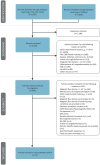Biological and health-related effects of weak static magnetic fields (≤ 1 mT) in humans and vertebrates: A systematic review
- PMID: 32516313
- PMCID: PMC7282627
- DOI: 10.1371/journal.pone.0230038
Biological and health-related effects of weak static magnetic fields (≤ 1 mT) in humans and vertebrates: A systematic review
Abstract
Background: There is a rapid development in technologies that generate weak static magnetic fields (SMF) including high-voltage direct current (HVDC) lines, systems operating with batteries, such as electric cars, and devices using permanent magnets. However, few reviews on the effects of such fields on biological systems have been prepared and none of these evaluations have had a particular focus on weak SMF (≤ 1 mT). The aim of this review was to systematically analyze and evaluate possible effects of weak SMF (≤ 1 mT) on biological functioning and to provide an update on the current state of research.
Methods: This review was prepared in accordance with the PRISMA (Preferred Reporting Items for Systematic Reviews and Meta-Analyses) statement. Methodological limitations in individual studies were assessed using the Office of Health Assessment and Translation (OHAT) Risk-of-Bias Rating Tool.
Results: Eleven studies fulfilled the eligibility criteria and were included in this review. All included studies were experimental animal studies as no human studies were among the eligible articles. Eight of the eleven studies reported responses of rat, rabbits and quails to weak SMF exposure that were expressed as altered melatonin biosynthesis, reduced locomotor activity, altered vasomotion and blood pressure, transient changes in blood pressure-related biochemical parameters, or in the level of neurotransmitters and increases in enzyme activities. It remained largely unclear from the interpretation of the results whether the reported effects in the evaluated studies were beneficial or detrimental for health.
Conclusion: The available evidence from the literature reviewed is not sufficient to draw a conclusion for biological and health-related effects of exposure to weak SMF. There was a lack of homogeneity regarding the exposed biological systems and the examined endpoints as well as a lack of scientific rigor in most reviewed studies which lowered credibility in the reported results. We therefore encourage further and more systematic research in this area. Any new studies should particularly address effects of exposure to SMF on biological functioning in humans to evaluate whether SMF pose a risk to human health.
Conflict of interest statement
The authors have declared that no competing interests existed during the conduct of the study. However, during the revision of the document, DS has become an employee of Amprion GmbH, a German grid operator.
Figures
References
-
- Moyer RM, Song G. Cultural predispositions, specific affective feelings, and benefit–risk perceptions: explicating local policy elites’ perceived utility of high voltage power line installations. J Risk Res. 2019;22(4): 416–431.
-
- Wiedemann PM, Boerner F, Claus F. How far is how far enough? Safety perception and acceptance of extra-high-voltage power lines in Germany. J Risk Res. 2018;21(4): 463–479.
-
- Russell CL. 5 G wireless telecommunications expansion: Public health and environmental implications. Environ Res. 2018;165: 484–495. - PubMed
-
- Draetta L. The social construction of a health controversy. The case of electricity smart meters in France. Ann Telecommun. 2019;74(1–2): 5–15.
-
- Ptitsyna NG, Ponzetto A, Kopytenko YA, Ismagilov VS, Korobeinikov AG. Electric Vehicle Magnetic Fields and Their Biological Relevance. J Sci Res Rep. 2014;3(13): 1753–1770.
Publication types
MeSH terms
Substances
LinkOut - more resources
Full Text Sources



